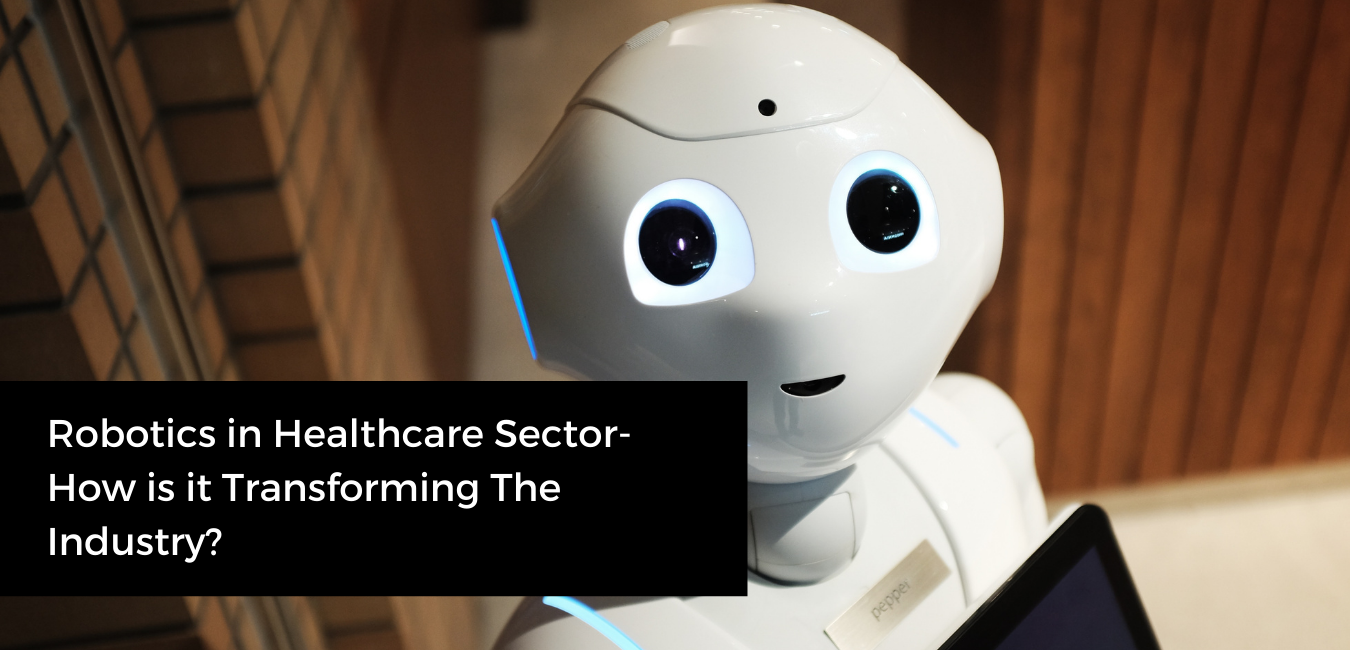Robotics in Healthcare Sector - How is it Transforming The Industry

Technological innovations are transforming our everyday lives. And the healthcare industry is no different. From inducing artificial intelligence into the regular diagnosis and detection to integrating machine learning for faster drug discovery, innovations pave the path for a better and healthy tomorrow.
The use of robotics is yet another way technology is transforming the healthcare sector. In fact, it is rapidly growing in the healthcare landscape. But the history of robots dates back to 1985 when for the very first time, “PUMA- a robotic arm” assisted the surgeons. And guess what, that neurosurgical biopsy was a complete success.
With the advances in sensor and motion control techniques, robots are moving towards more precision and autonomy. The innovations are so advanced that robots can now assist and even carry out complex surgeries by themselves.
So, what’s happening around in this space?
Back in 2015, Google announced a project with the pharma giant Johnson & Johnson. They wanted to create a surgical robot system in the lines of Verb Surgical. In fact, in 2018, Google’s co-founder Sergey Brin used that robot to suture some synthetic tissue.
Further, J&J bought Auris, which is known to develop robotic technologies focused on lung cancer. The most commonly used surgical robot is the da Vinci Surgical System, which has been here for more than 15 years. It has a magnified 3D high-definition vision system and wristed instruments to bend and rotate to a far extent where human hands usually fail to reach.
Let’s talk about more examples.
- Akara developed an autonomous robot prototype. They are testing it to disinfect contaminated surfaces using UV light. The goal is to help hospitals sanitize rooms and equipment and combat the spread of COVID-19.
- The Xenex Germ-Zapping Robot is another automated robot that helps healthcare providers to disinfect hospital rooms within a few minutes using full-spectrum UV rays. Its primary purpose is to reduce hospital-acquired infections like MRSA.
- The PARO therapeutic robot helps elderly patients with dementia to reduce stress and provides comfort to anxious patients. The best part about this robot is that it responds to its names and develops a customized approach.
- The CyberKnife is a surgery system that helps deliver radiation therapy to tumors with even sub-millimeter precision. They are often used for tumors in areas like the prostate, neck, head, and liver. It is remarkably effective for prostate cancer.
Does that mean robots will take the job? Such stories often paint a different picture of these futuristic innovations. But introducing such technologies will help the human workforce in the healthcare sector create a professionally satisfied workforce.
Remember, labor is one of the significant parts of any healthcare cost. And it accounts for around 60% of non-capital expenses, and the prices are continuing to grow. Plus, most work in this space is routine and repetitive. This is where robotics takes the upper hand. While the surgeon is 100% in control of the robotic system, they can easily carry out precise operations and repetitive tasks. In short, they are increasing the efficiency of surgical procedures for better outcomes.
Now that we are aware of its importance in the new-age healthcare space, the next question that comes to mind is…
What Are The Types of Robots Used in the Healthcare Industry?
- Modular Robots: Their role is mainly to enhance other systems. In fact, one can configure it to perform a variety of functions. The therapeutic exoskeleton robots or prosthetic arms and legs are usually a part of this category. Such robots can help patients recover after a stroke, paralysis, traumatic brain injuries, or multiple sclerosis. They can help patients monitor when they are taking part in prescribed exercises, measuring degrees of motion. Thus, tracking the progress precisely. When integrated with AI, they can also act as a coach in helping patients to finish their respective exercises necessary for rehabilitation.
- Service Robots: Their primary aim is to relieve the daily burden of healthcare providers in handling their standard logistical tasks. A lot of such robots can easily send a report after completing their task. For example, these robots can help set up a patient room, track supplies, and restock medical supplies. Thus, giving the healthcare providers to take care of immediate patient needs.
- Social Robots: Their role is to interact with humans. Their use is for long-term patient care. Thus, providing an environment to provide social interaction and monitoring at the same time. They will enable patients to comply with the treatment while providing engagement that allows them to stay alert and cheerful. One can use the same robot to offer direction to visitors and patients inside a hospital. Thus, reducing the workload of caregivers while improvising patients’ emotional well-being.
- Mobile Robots: They move around hospitals or clinics at a predefined track. They have a variety of functions. For instance, they can help transport patients, move heavy medical machinery, and disinfect rooms.
- Autonomous Robots: These robots can self-navigate patients in hospital rooms. Thus, enabling the clinicians to examine and interact with high-risk patients from far. It helps specialists to provide patients with on-screen consultations or patient diagnosis. And since these robots are keeping track of their own, they can go back to their stations when they need charging. They can also help perform disinfection, navigating through high-risk wards, operating rooms, and public spaces.
Final Words- Robotics Innovation Making Inroads in Medical Industry
Robotics in healthcare is increasing the overall patient outcomes while helping health workers perform duties with utmost care. You can expect the following benefits when investing in this technological innovation.
- High-quality Patient Care: They support minimally invasive procedures and help the providers with customized and frequent patient monitoring. Thus, alleviating the workloads of nurses and caregivers, which further enhances long-term patient care.
- Improve Operational Efficiencies: Service robots enable hospitals to streamline their routine tasks, reducing the physical demands on the human workforce. Therefore, it ensures consistency in various processes, such as medical supplies, cleaning, and disinfection.
- Enhancing Safety at Hospitals: Since these robots are pretty helpful in disinfection and transportation of supplies in a high-risk zone, they can help reduce exposure to pathogens.
So, are you ready for this futuristic technology? Or are you still procrastinating?










